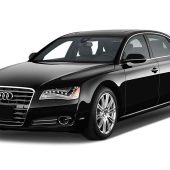Premiere for Audi Sport: the Audi R18 TDI, with which Audi Sport Team Joest contests the 24 Hours of Le Mans on June 11-12, is the first Audi race car to be developed with the aid of the new climatic wind tunnel. Since the beginning of 2008 the climatic wind tunnel completes the Audi Wind Tunnel Center in Ingolstadt. It creates temperatures between minus 25 and plus 55 degrees Celsius and allows engineers to generate freezing cold and blisteringly hot wind speeds of up to 300 kilometers per hour. The simulation of sunlight and rain are also possible.
Especially for the Audi R18 TDI, the opportunity to use the climatic wind tunnel operated by their production colleagues was extremely valuable for the Audi Sport technicians. The new LMP1 is Audi’s first closed Le Mans sports car since the R8C in 1999. “The climatic wind tunnel is an example of the extensive cooperation with Technical Development (TE),” explains Dr. Martin Mühlmeier, Head of Technology at Audi Sport. “The TE develops constantly and as part of TE Audi Sport is allowed to use these resources. Conversely, our colleagues from production development benefit from our findings from motorsport.”

Work on the R18 TDI in the climatic wind tunnel focused on three areas: optimized airflow through the cockpit, the windscreen and testing the windscreen wiper. “In this case we can rely on the findings from the climatic wind tunnel – it’s a great benefit to have such an extremely high quality tool available,” says Christopher Reinke, Technical Project Leader for the R18 TDI. “The results of everything which we have tested in the climatic wind tunnel up to now have been confirmed during testing on the race track.”
In the climatic wind tunnel ventilation of the closed cockpit was optimized to such an extent that the R18 TDI will manage without air-conditioning at Le Mans. As this costs both weight and power the engineers were happy to exclude the use of such a system. The deposit of rain water or solid materials such as sand, rubber pick-up and stones was also simulated. “We made many valuable discoveries in this area on the full scale car in the climatic wind tunnel and modified several things and especially in the airflow area,” says Dr. Martin Mühlmeier. “The reflective film on the roof was also validated with findings from the climatic wind tunnel. These are all important details to guarantee a good climate around the driver in the cockpit.”










